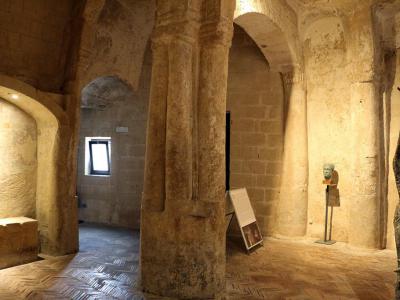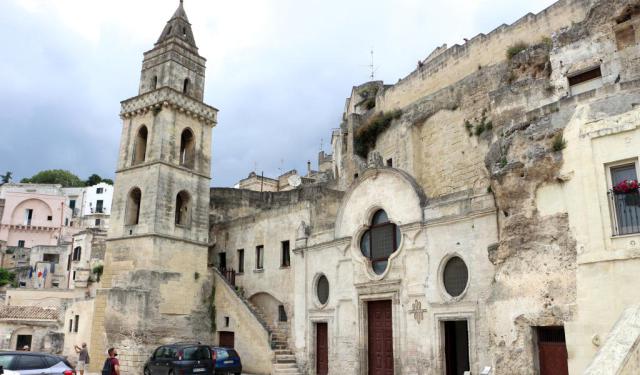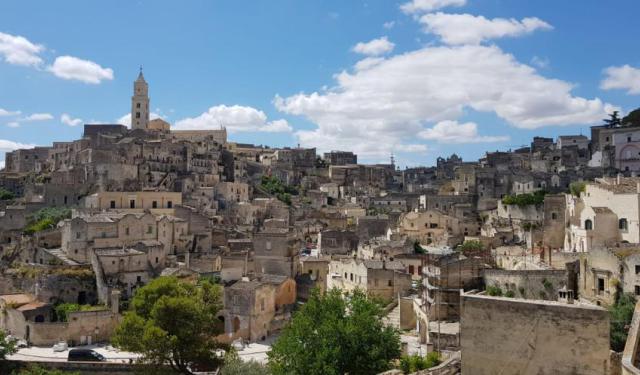
Rock Complex of Madonna of the Virtues and Saint Nicholas of the Greeks, Matera
The rupestrian churches of Matera are buildings carved into limestone rock. These structures were created in the early Middle Ages. The rock church Madonna of the Virtues (Madonna delle Virtu) was built circa 1000 AD. The adjoining monastery was the home of refugee nuns from Acre or Accon in the Middle East.
The church has a basilica plan of three naves divided by large columns. The columns support "donkey-back" vaults. The women's gallery has arches and columns in relief. The nave apses are semicircular. The vault forms a dome inscribed with a Greek cross in relief. The entrance is from a side nave; road construction in 1934 cut it in half.
The central apse has an 18th-century fresco of the Virgin and Saint John at the crucifixion. The right aisle holds a Gothic, 14th, or 15th-century crucifixion. There is a tuff quarry chamber in the middle of the right nave.
The penitent nuns of Saint Maria di Accon were brought to Matera's Madonna of the Virtues in 1198. They moved in the 13th century to the monastery of Santa Maria Foggiali, the San Giovanni Battista of today.
Above the church is the 10th-century monastery of Saint Nicholas of the Greeks (San Nicola Dei Greci). It is probably the oldest crypt in Matera. It has two naves and apses. The apsidal basin houses a 14th-century fresco of the crucifixion. In the left aisle is a 13th-century triptych of saints. Today, the church and the crypt of Saint Nicholas of the Greeks are used as art exhibition spaces.
The church has a basilica plan of three naves divided by large columns. The columns support "donkey-back" vaults. The women's gallery has arches and columns in relief. The nave apses are semicircular. The vault forms a dome inscribed with a Greek cross in relief. The entrance is from a side nave; road construction in 1934 cut it in half.
The central apse has an 18th-century fresco of the Virgin and Saint John at the crucifixion. The right aisle holds a Gothic, 14th, or 15th-century crucifixion. There is a tuff quarry chamber in the middle of the right nave.
The penitent nuns of Saint Maria di Accon were brought to Matera's Madonna of the Virtues in 1198. They moved in the 13th century to the monastery of Santa Maria Foggiali, the San Giovanni Battista of today.
Above the church is the 10th-century monastery of Saint Nicholas of the Greeks (San Nicola Dei Greci). It is probably the oldest crypt in Matera. It has two naves and apses. The apsidal basin houses a 14th-century fresco of the crucifixion. In the left aisle is a 13th-century triptych of saints. Today, the church and the crypt of Saint Nicholas of the Greeks are used as art exhibition spaces.
Want to visit this sight? Check out these Self-Guided Walking Tours in Matera. Alternatively, you can download the mobile app "GPSmyCity: Walks in 1K+ Cities" from Apple App Store or Google Play Store. The app turns your mobile device to a personal tour guide and it works offline, so no data plan is needed when traveling abroad.
Rock Complex of Madonna of the Virtues and Saint Nicholas of the Greeks on Map
Sight Name: Rock Complex of Madonna of the Virtues and Saint Nicholas of the Greeks
Sight Location: Matera, Italy (See walking tours in Matera)
Sight Type: Religious
Guide(s) Containing This Sight:
Sight Location: Matera, Italy (See walking tours in Matera)
Sight Type: Religious
Guide(s) Containing This Sight:
Walking Tours in Matera, Italy
Create Your Own Walk in Matera
Creating your own self-guided walk in Matera is easy and fun. Choose the city attractions that you want to see and a walk route map will be created just for you. You can even set your hotel as the start point of the walk.
Matera's Ancient Cave Churches
Within the old city of Matera, there are more than 160 churches. Many of these are actually carved into the soft limestone cliffs lining the Gravina River. There are even some used for pagan rituals. The churches were carved from existing caves and tunnels. More than a few sanctified cave churches have been converted to storage and homes.
A good example to start with is the St. Anthony... view more
Tour Duration: 1 Hour(s)
Travel Distance: 1.7 Km or 1.1 Miles
A good example to start with is the St. Anthony... view more
Tour Duration: 1 Hour(s)
Travel Distance: 1.7 Km or 1.1 Miles
Matera Introduction Walking Tour
Architectural historian Anne Parmly Toxey said the cave areas of Matera had been occupied for at least 3,000 years. There have been settlements in Matera since the Paleolithic era.
The town itself was founded in 251 BC by Roman consul Lucius Caecilius Metellus. He called it Matheola. Subsequently, the town was occupied by Longobards, Byzantines, Saracens, Swabians, Angevins, Aragonese, and... view more
Tour Duration: 2 Hour(s)
Travel Distance: 2.4 Km or 1.5 Miles
The town itself was founded in 251 BC by Roman consul Lucius Caecilius Metellus. He called it Matheola. Subsequently, the town was occupied by Longobards, Byzantines, Saracens, Swabians, Angevins, Aragonese, and... view more
Tour Duration: 2 Hour(s)
Travel Distance: 2.4 Km or 1.5 Miles


